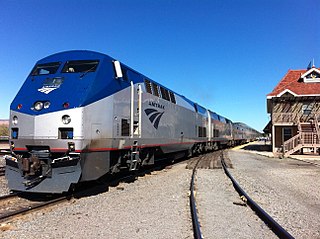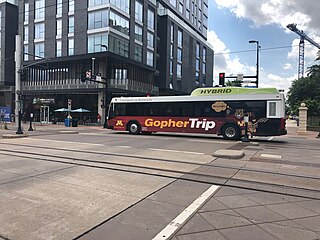SLO Transit is the provider of mass transportation in the city of San Luis Obispo, California. SLO Transit operates 10 vehicles at peak along eight fixed-routes within the 23 square miles of the city limits of San Luis Obispo and California Polytechnic State University (Cal Poly). SLO Transit operates Monday to Friday approximately from 6am to 11pm, and Saturday and Sunday from 8am to 8pm.
SLO Transit's ridership has increased steadily. It transports over 1.1 million riders annually. SLO Transit ridership demographics reflect a broad cross section of riders, including: seniors, people with disabilities, socially or economic transit dependent, K-12 students, college students, working professionals and choice riders. Operation and maintenance of all fixed-route services are contracted out to First Transit Inc., a third-party vendor.
SLO Transit provides its fixed route transit system information via various formats, including: online at slotransit.org, printed materials, Google & Bing Maps, Social Media, “Bus Tracker” smart phone application, City Hall (990 Palm Street, San Luis Obispo), the Transit Center, Parks & Rec Facilities, County Library & Offices, San Luis Obispo Council of Governments office (SLOCOG), by phone, print advertising, on vehicles, at bus stops, community centers and via neighboring transit agencies (e.g., SLO RTA).
The public has direct access for participating in the improvements and management of SLO Transit services. By direction of the City Council the Mass Transportation Committee (MTC) was formed in 1972 to provide them input on matters related to transit. The committee is an advisory body of citizen volunteers. Their purpose is to gather input and represent the general public on matters of setting priorities and to include input during the planning processes. MTC advisory body includes representation from the: Senior, Disabled, Technical, Student and General community.
SLO Transit has received many awards for its system including qualifying for Small Transit Intensive Cities (STIC) funding, a funding source only granted to cities that provide a greater level of service than which their city's population size would suggest.
For para-transit services, SLO Transit provides part of its funding allocation, off-the-top, to the county's consolidated para-transit service provider known as Run-About, operated by SLO Regional Transit Authority (SLO RTA), who also provides the fixed-route services to the other cities and parts of the county.
Metro Transit is the primary public transportation operator in the Minneapolis–Saint Paul area of the U.S. state of Minnesota and the largest operator in the state. Although Metro Transit is one of the smallest transit systems for a large metropolitan area in the United States, it has previously been ranked as one of the best. In 2023, the system had a ridership of 44,977,200, or about 145,600 per weekday as of the fourth quarter of 2023.

Paratransit or Intermediate Public Transport, is a type of transportation services that supplement fixed-route mass transit by providing individualized rides without fixed routes or timetables. Paratransit services may vary considerably on the degree of flexibility they provide their customers. At their simplest they may consist of a taxi or small bus that will run along a more or less defined route and then stop to pick up or discharge passengers on request. At the other end of the spectrum—fully demand responsive transport—the most flexible paratransit systems offer on-demand call-up door-to-door service from any origin to any destination in a service area. In addition to public transit agencies, paratransit services may be operated by community groups or not-for-profit organizations, and for-profit private companies or operators.

The Charleston Area Regional Transportation Authority (CARTA) provides area residents and visitors public transportation within parts of Charleston and Dorchester counties in the Lowcountry region of South Carolina, including the cities of Charleston, North Charleston and the surrounding communities of Mount Pleasant, Summerville, James Island, Sullivan's Island, and the Isle of Palms. CARTA presently contracts with Transdev for staffing and managing the bus drivers in addition to maintaining and scheduling the buses. In 2023, the system had a ridership of 2,191,500, or about 7,100 per weekday as of the fourth quarter of 2023.

GoRaleigh is the transit system responsible for operating most of the public transportation services in Raleigh, North Carolina. The system operates 27 fixed routes throughout the city's municipal area and also operates five regional/express routes in partnership with GoTriangle, the regional provider. GoRaleigh is contracted to operate two additional routes, an express route to the Wake Tech Community College campus south of Raleigh and a local circulator service in the Town of Wake Forest. Capital Area Transit, also known as CAT, was rebranded to GoRaleigh in 2015 under the consolidated GoTransit, a joint branding of municipal and regional transit systems for the Research Triangle. In 2023, the system had a ridership of 5,094,000, or about 14,900 per weekday as of the fourth quarter of 2023.

Chapel Hill Transit operates public bus and van transportation services within the contiguous municipalities of Chapel Hill and Carrboro and the campus of the University of North Carolina at Chapel Hill in the southeast corner of Orange County in the Research Triangle metropolitan region of North Carolina. Chapel Hill Transit operates its fixed route system fare free due to a contractual agreement with the two towns and the university to share annual operating and capital costs. In 2023, the system had a ridership of 3,855,400, or about 16,600 per weekday as of the fourth quarter of 2023.

The Minnesota Valley Transit Authority, also known by the acronym MVTA, is a public transportation agency that serves seven communities in the southern portion of the Minneapolis–Saint Paul metropolitan area. The agency provides fixed-route and demand-responsive transit within the service area of the communities and to select destinations in the region.

Plymouth Metrolink is the public transit system that serves Plymouth, Minnesota. Metrolink operates fixed-route bus routes Monday-Friday during peak periods with limited midday service. Most routes serve downtown Minneapolis and the University of Minnesota with one route providing reverse commute service from Minneapolis to employers in Plymouth. Demand-responsive bus service is available seven days a week. Most buses are provided by the Metropolitan Council with First Transit operating the fixed-route service.

The Riverside Transit Agency (RTA) is the main transit agency for western Riverside County, California, United States. RTA provides both local and regional services throughout the region with 39 fixed-routes, 9 CommuterLink routes, and Dial-A-Ride services using a fleet of 339 vehicles. In the cities of Corona, Beaumont and Banning, RTA coordinates regional services with municipal transit systems. In Riverside, RTA coordinates with the city's Riverside Special Services, which provides ADA complementary service to RTA's fixed-route services.

Marin Transit is a public bus agency in Marin County, California, in the United States. Originally formed in 1964 as Marin County Transit District (MCTD). Marin Transit was re-branded on 30 July 2007 and now provides a variety of fixed-route and demand-response services using contractors. In 2023, the system had a ridership of 2,814,700, or about 8,800 per weekday as of the fourth quarter of 2023.

The Yuma County Area Transit (YCAT) system is a public transportation system based in Yuma County, Arizona. Since 1990 the agency has grown from a new transit service offering paratransit to the current mix of fixed-route and demand-responsive services serving over 32,000 riders per month, with an annual operating budget of $2.5 million. YCAT is also the local Greyhound Lines agent.
Go COMO, formerly Columbia Transit, is a city-owned public bus system that serves the city of Columbia, Missouri. The system operates Monday through Saturday, except on major holidays. Services include fixed-route services, bookings for para-transit shuttles for the disabled, a system of commuter shuttles for students and employees of the University of Missouri, and hotel shuttles during MU football games. In fiscal year 2009, 2,007,263 rides were logged along the system's six fixed routes and University of Missouri Shuttle routes, while the latest available records show 27,000 rides logged aboard the para-transit service.

The United States is serviced by a wide array of public transportation, including various forms of bus, rail, ferry, and sometimes, airline services. Most established public transit systems are located in central, urban areas where there is enough density and public demand to require public transportation. In more auto-centric suburban localities, public transit is normally, but not always, less frequent and less common. Most public transit services in the United States are either national, regional/commuter, or local, depending on the type of service. Sometimes "public transportation" in the United States is an umbrella term used synonymously with "alternative transportation", meaning any form of mobility that excludes driving alone by automobile. This can sometimes include carpooling, vanpooling, on-demand mobility, infrastructure that is oriented toward bicycles, and paratransit service. There is public transit service in most US cities.
The San Luis Obispo Regional Transit Authority is the provider of intercity mass transportation in San Luis Obispo County, California, with service between most cities in the county: Arroyo Grande, Atascadero, Paso Robles, Grover Beach, Morro Bay, Pismo Beach, Cambria, San Simeon, Los Osos, Cayucos, and San Luis Obispo. Hourly routes operate Monday - Friday, with limited Saturday & Sunday service. The base travel fare is $1.75-$3.25 each way, or a Regional day pass may be purchased for $5.50, good for unlimited trips on all fixed-routes in the county. Five routes are branded as part of the SLORTA. RTA also operates fixed route transit service in Paso Robles and the Five Cities Area for South County Transit and the Avila Beach Trolley on a seasonal/summer runs.

Yakima Transit is the primary provider of mass transportation in the city of Yakima, Washington. It was established in 1966, as Yakima City Lines, when the city of Yakima began funding the provision of transit service after the privately owned company that had been providing service went bankrupt.

The University of Minnesota's Campus Shuttle is a zero-fare bus service operating on the University's Minneapolis and St. Paul campuses. In 2009, the system carried more than 3.9 million riders, making it the second-busiest transit system in Minnesota after the Twin Cities's primary provider Metro Transit. It outpaces all of the suburban transit providers in the Twin Cities, as well as providers in other metropolitan areas in the state. Duluth Transit Authority serving Duluth, Minnesota, and Superior, Wisconsin, is the state's third-busiest provider, while the Minnesota Valley Transit Authority ranks fourth. The shuttles are operated under contract by First Transit through the University's Parking and Transportation Services (PTS) department.
Twin Cities Area Transportation Authority (TCATA) is an urban/rural transit provider that provides fixed-route and dial-a-ride bus transit service throughout the Benton Harbor, Michigan-Saint Joseph, Michigan area. It was established in 1974. It is funded through federal grants and state and local funds. and run by the elected Board of Trustees with consultation from the Local Advisory Council made up of residents within the service area.

SolTrans, officially Solano County Transit, is a Joint Powers Authority that provides public transportation service to the southern Solano County cities of Vallejo and Benicia. SolTrans was established in 2011 and is the result of a merger between Vallejo Transit and Benicia Breeze. In 2023, the system had a ridership of 954,200, or about 3,700 per weekday as of the fourth quarter of 2023.
Go West Transit is the primary provider of mass transportation in McDonough County, Illinois with routes serving Western Illinois University and the Macomb area. The system runs 17 routes with over 100 stops and is the only fare-free transit system in Illinois. As of 2019, the system provided 841,943 rides over 45,934 annual vehicle revenue hours with 18 buses and 10 paratransit vehicles.

Butler County Regional Transit Authority, also stylized as BCRTA, is the primary provider of mass transportation in Butler County, Ohio with twelve routes serving the region. As of 2019, the system provided 620,233 rides over 70,789 annual vehicle revenue hours with 18 buses and 17 paratransit vehicles.















